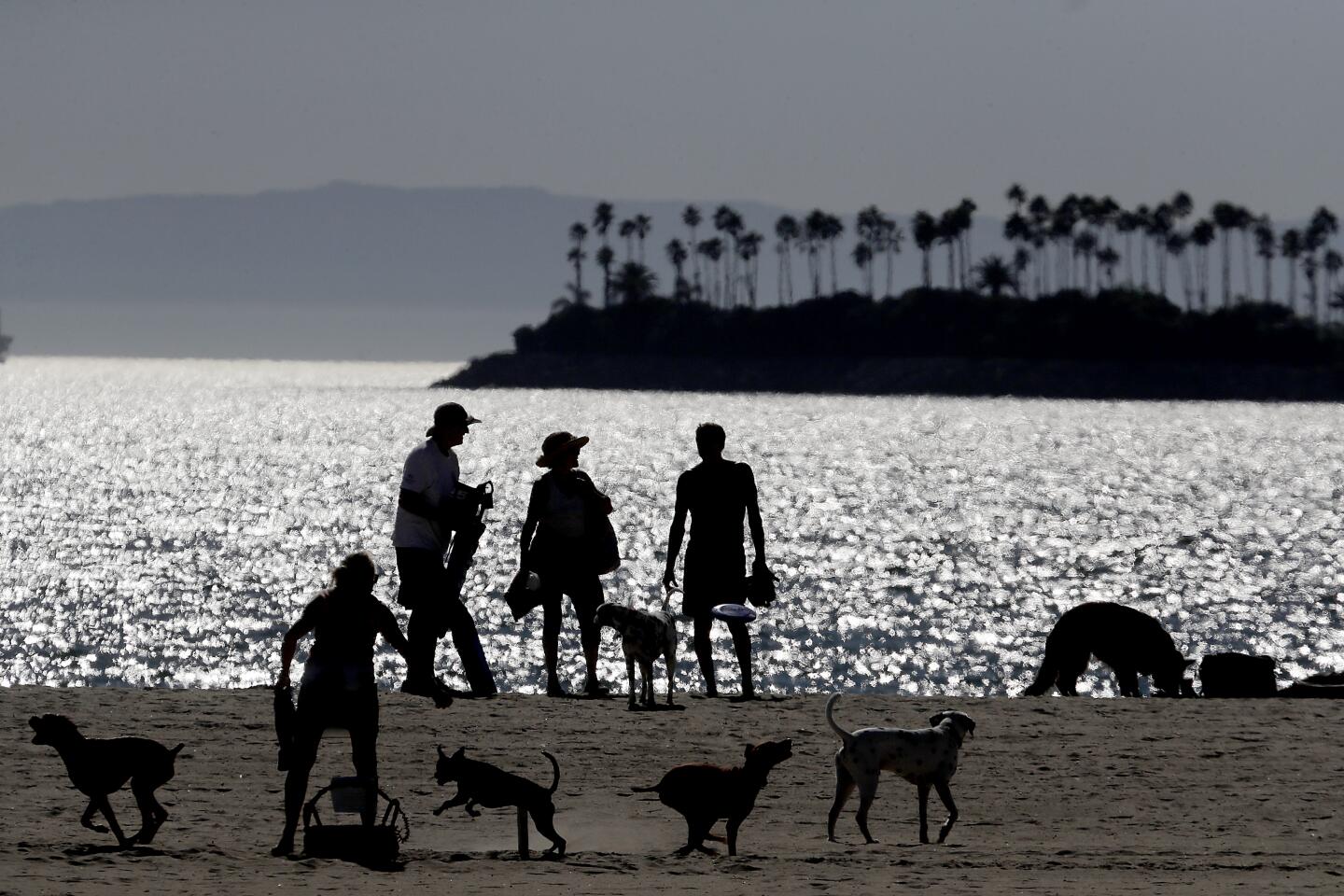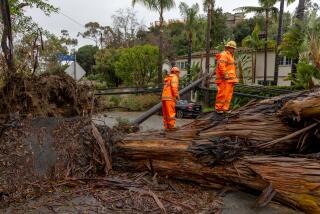More than 500,000 California utility customers could lose power as strong winds pick up

More than half a million utility customers could lose power this week as California braces for hot weather, strong winds and the heightened potential for fast-moving wildfires.
Southern California Edison said more than 308,000 customers in seven counties — Ventura, Los Angeles, San Bernardino, Riverside, Orange, Kern and Santa Barbara — could face blackouts starting Wednesday night and rolling into midday Thursday.
Pacific Gas & Electric Co. on Wednesday shut off power to customers in the Sierra Nevada foothills about 2 p.m. An hour later, counties in the north San Francisco Bay Area began to lose service. By 1 a.m. Thursday, portions of San Mateo and Kern counties will also be in the dark. In total, 179,000 customers are expected to have their power cut.
San Diego Gas & Electric Co. has identified about 24,000 customers in several communities that may be subject to a power shut-off because of high winds.
In all, the three utility companies’ outages could affect more than 1 million Californians.
But, at least for Northern California, there’s potentially worse news ahead.
The National Weather Service in Sacramento is forecasting another wind event starting late Saturday that could be the strongest so far this fall. “Downed trees, power outages & difficult driving conditions are possible,” the weather service said Wednesday in a tweet.
On Wednesday night, PG&E officials told reporters at a news conference that they’re anticipating another “public safety power shut-off” this weekend if that forecast comes to fruition.
When asked whether some customers could lose power during the current shut-off and then again be affected by the weekend shut-off, PG&E officials were cautiously nonspecific.
“Our plan, given the projected all-clear, is that we will have everybody restored who could be affected by the second one before it happens, so our plan is to hook everybody back up and then at some point see what those forecasts actually lead to, but we intend to restore everybody,” PG&E Chief Executive Bill Johnson said.
PG&E anticipates that “all clear” moment will be noon Thursday. The utility has said it could take up to 48 hours to restore all customers’ power.
PG&E made the decision to cut power based on forecasts of hot, dry weather and so-called Diablo winds that pose a higher risk for damage and sparks on the company’s electric system, which officials fear could ignite a wildfire.
Edison and SDG&E have expressed similar concern over Santa Ana winds that were expected to hit the southern portion of the state by late Wednesday.
“The general consensus is that this will be a high-risk weather event unfolding,” said Scott Strenfel, a meteorologist for PG&E.
The PG&E shut-off was expected to affect customers in 17 counties: Alpine, Amador, Butte, Calaveras, El Dorado, Kern, Lake, Mendocino, Napa, Nevada, Placer, Plumas, San Mateo, Sierra, Sonoma, Tehama and Yuba. That includes 143,000 customers in the Sierra Nevada foothills, 36,000 in the North Bay, fewer than 1,000 in San Mateo County and fewer than 100 in Kern County.
One former PG&E meteorologist said it remains unclear how the utility chose the much smaller footprint for this week’s shut-off.
The wind forecasts for this week are not markedly different from those expected Oct. 9, when the company began a shut-off that eventually hit 738,000 customers in 35 Northern and Central California counties.
The National Weather Service’s projections for offshore winds beginning this week are similar, but PG&E this time said its shut-off will affect about one-fourth as many customers in about half as many counties.
“Is that a response to public opinion, or is it a response to actual data?” asked Craig Smith, a former PG&E weather expert and now a fire scientist with the consulting firm Jupiter Intelligence. “Is it a response to some sort of study on the actual meteorology of these events?”
Smith said “it’s obvious there is a lot of human intervention going on” in reconfiguring the “de-energization polygons” for this week’s shut-off, but he said he preferred to study data rather than try to assess the motivations of his former PG&E colleagues.
The fire weather expert called for “information transparency” so outside experts and the general public better understand how the giant utility decides where and when to shut off power.
Forecasters say peak winds up to 60 mph in some areas should subside by noon Thursday in the Sierra foothills, the North Bay and San Mateo County, and by around noon Friday in Kern County.
Once the winds calm, the utility said, it would inspect the de-energized lines to ensure they aren’t damaged before turning power back on. However, many customers could be without power for two days or more after the winds subside, according to the utility.
PG&E has roughly 8,000 miles of overhead distribution systems and 650 miles of transmission systems to patrol. The company will use a small army of 6,000 field resources performing ground patrols, 42 helicopters and one fixed-wing airplane with a high-resolution camera and infrared technology.
The utility companies’ power shut-offs have generated backlash from customers, with some residents saying the outages create a whole new set of dangers as they try to watch for news about fires. Critics worry that communications and evacuations will be hampered if the power is out, especially if traffic signals don’t work and cellphone service is affected.
Gov. Gavin Newsom has also stepped up his criticism of PG&E, which was roundly excoriated this month over chaotic power shutdowns that affected millions across Northern California.
“I believe the unacceptable scope and duration of the previous outage … was the direct result of decades of PG&E prioritizing profit over public safety,” Newsom wrote in a letter to PG&E on Tuesday.
Johnson, the PG&E executive, addressed the letter during a news conference Tuesday evening, saying the company “shares the governor’s focus on public safety and preventing catastrophic wildfires.”
“And that’s the sole intent of the public safety power shut-off program — to prevent catastrophic fires which electrical equipment can spark,” Johnson said.
In a news conference the next evening, Johnson addressed a different issue the company has faced during the shut-off: threats of violence to its employees.
During the last shut-off, the California Highway Patrol was called to investigate someone shooting at a PG&E truck. A PG&E office in Oroville was reportedly egged.
On Wednesday night, Johnson said there were preliminary reports of pellet-gun fire hitting the front passenger window of a PG&E vehicle driven by an employee in Glenn County.
“There is no justification for this sort of violence,” Johnson said. “Whenever you see any of our crews anywhere in your community, they’re there to help, specifically to help you. They’re not anonymous strangers. They’re your neighbors, they’re your friends. Most of our front-line employees live in the communities where they work. So I understand that these shut-offs can make people upset or even angry, but be upset at PG&E, and don’t take it out on the people that are trying to help you.”
California is in the midst of a fall heat wave brought on by a mixture of high pressure and offshore winds that have raised temperatures at least 10 degrees higher than usual across much of the state, forecasters say.
Forecasts of strong winds, temperatures surpassing the 90- and 100-degree marks and low humidity prompted the National Weather Service to issue red-flag warnings beginning Wednesday in a large swath of Northern California as well as Los Angeles and Ventura counties. Those conditions create a prime environment for explosive wildfires, experts say.
Equipment malfunctions have been tied to some of the state’s most destructive and deadliest fires, including last year’s Camp fire, which devastated the town of Paradise in Northern California and killed 85 people, and the 2017 wine country blazes.
Investigators determined last year that Edison power lines ignited the 2017 Thomas fire, a massive blaze in Ventura and Santa Barbara counties that killed two people. Officials are still trying to determine whether power lines sparked the Woolsey fire, which ripped through Ventura County and Malibu in November 2018.
Southern California Edison has also faced scrutiny over possible links between the company’s electrical system and the start of the Saddleridge fire, which scorched nearly 8,800 acres in the hills of the northern San Fernando Valley this month and destroyed several homes.
In PG&E’s earlier power shut-off this month, the company said it found more than 130 cases of damage after inspecting its lines after the wind event.
In Glenn County, a large tree limb was found lying across an electric line. In Napa County, another large tree limb was found tangled with a span of wires.
“Wind gusts exceeded 50 mph in 16 of the 35 counties in the PSPS footprint, and damage or hazards were found in nearly all of them,” the company said in a news release. “It is possible that these damages and hazards represented potential sources of wildfire ignition.”
Whether Californians believe that, or think the shut-offs are worth it, will become more clear through the week, largely determined by whether any wildfires are sparked by live power lines.
Times staff writer James Rainey contributed to this report.
More to Read
Start your day right
Sign up for Essential California for news, features and recommendations from the L.A. Times and beyond in your inbox six days a week.
You may occasionally receive promotional content from the Los Angeles Times.














